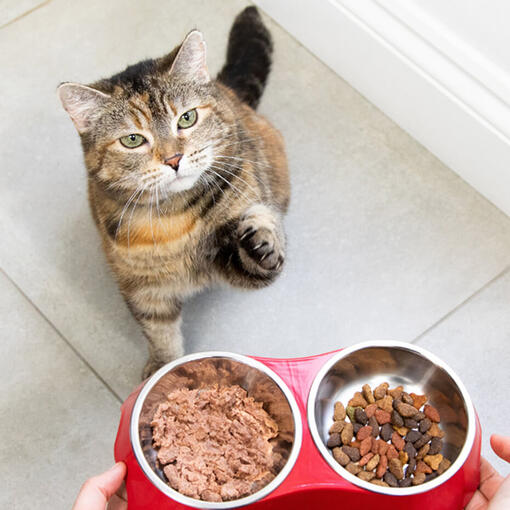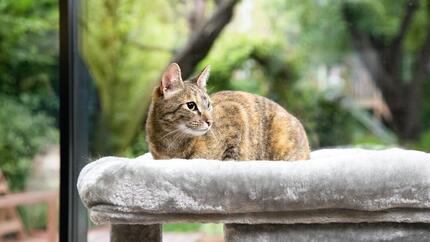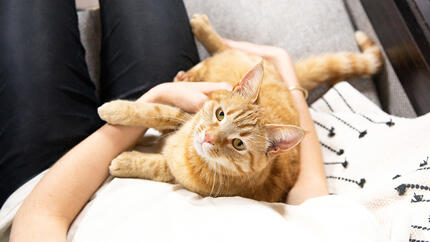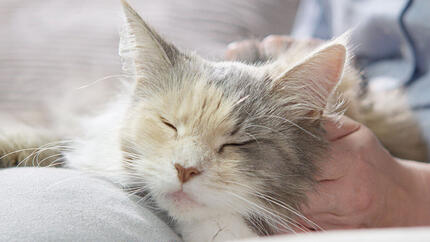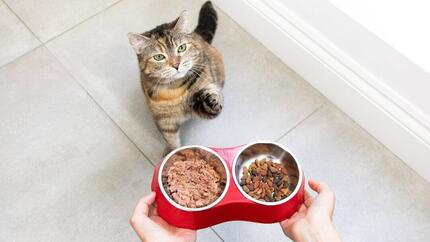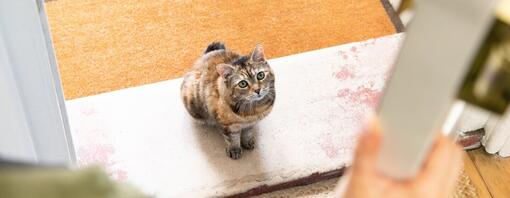
If you’re expecting new bundles of fur arriving at your home soon, it can be exciting – but perhaps a little daunting too.
As long as you are prepared and know what to expect, there is no need to worry unduly - pregnant cats are usually more than capable of taking care of themselves, although they will still need close care and supervision from you during labour. As they often try to sneak away to give birth in private, you’ll need to keep a close eye on them in the last few weeks just in case! Speak to your vet if you have any concerns about pregnancy in cats, or are worried about your cat giving birth. Their advice should help to put your mind at rest.
Here are some helpful tips from our PetCare Team to help you be as prepared as possible for when your cat becomes a new mum.
How to prepare for cat birth
Being prepared for cat labour and the birth of kittens is the best thing to do to ensure the process goes smoothly. Here are some ways to prepare:
Be quiet and calm around her
During the last two weeks of your cat’s pregnancy, make sure everyone in the family knows to be calm and quiet around her to make sure she feels safe and secure, and to try not to pick her up or handle her unduly (except for your usual displays of affection) It is important that children understand this too – as they can be understandably excited at the prospect of kittens to play with soon!
Create a cat birthing box
This should be prepared well in advance of your cat’s due date. This is so they get used to the box and see it as a safe space. Make sure the box is:
- Big enough for your cat (in width and height).
- Lined with bedding that’s absorbent, like towels.
- In a room that’s quiet, comfortable, and warm that your cat likes to be in.
- Is easy for her to get in and out of (but will keep her kittens secure in their first couple of weeks).
Encourage your cat to relax
Try to keep her as calm and settled as possible during this time, and encourage her to relax in her special whelping box. Move food bowls, water bowls and litter tray to places where she will not have to jump to get to them. Be aware that no matter how much work you have gone to create the perfect snuggliest kittening bed, some cats will reject your suggested spot for a corner of a cupboard! Just make sure she has some choice on where to give birth and never try to move her from her chosen spot. If she has a better idea, make it comfortable for her.
Have help on hand
Your cat’s labour should go smoothly, but it’s useful to have help on hand to keep her calm and in case she runs into any complications.
Get hold of your vet's out-of-hours phone number prior to your cat giving birth, as delivery often happens during the night, or they might need an emergency helping hand. If mum does have problems delivering her kittens, you may need to take her into the vet, so make sure that you have access to transport. If you have any friends who have experience of birthing kittens, ask them to come and keep you company.
Get the right supplies
When you think labour might be approaching, it’s good to get a few things ready in advance, like:
- Clean bowl of warm water.
- Clean towels and cloths.
- Dental floss.
- Disposable gloves.
- Cat carrier.
- Your vet’s details.
It’s important to have these things to hand, just in case!
If you need to move the kittens away from mum at any time, you’ll need to keep them warm. We recommend using a microwaveable beanie bag instead of a hot water bottle, as their sharp teeth and claws can cause punctures.
How do cats give birth? The stages of cat labour and delivery
Cat labour has three stages. Once you think labour has started, you should keep a watchful eye over her – cat labour usually goes very smoothly, but it’s important that you oversee her labour so any complications can be caught quickly. However, interfering unless it’s absolutely necessary might slow feline labour and upset your cat, so limit yourself to regular checks at a discreet distance, and try not to intervene unless you absolutely have to.
Don’t worry – generally, cat labours go very smoothly, but always consult your vet if you’re worried.
No matter how excited the rest of the family are, mum is not going to appreciate an audience and some cats find it really stressful. Have one person keeping an eye on mum and the rest can wait until the kittens have all arrived.
- You may not even notice the first stage, as the cervix and uterus are preparing for delivery.
- Contractions will start to happen but may not be visible to your watchful eye.
- Your cat will become very restless, pace as if she is looking for something, and be very vocal.
- She may also make several unproductive trips to the litterbox, but hopefully will settle into her maternity bed.
- Don’t be surprised if she chooses another spot, as she may not be used to her maternity bed or just fancy giving birth somewhere else. Don't move her - it's always safer to let her give birth where she chooses.
- She may also start experiencing a vaginal discharge.
- The second stage of feline labour is the birth of the kittens. This can last anything from 2 hours to 24 hours. Double check your birth kit and make sure you have everything to hand.
- Some kittens will be born head first (like human babies), but others will appear feet first and this is quite normal, so don’t worry if this happens.
- Kittens normally come at 30-45 minute intervals, but sometimes come over an hour apart.
- Stand and watch at a safe distance, and only intervene if absolutely necessary: if, for example, you see her straining hard without producing a kitten, there is a bloody discharge, or she passes kittens very quickly with no time to clean them/break the amniotic sacs. Read things to look out for during labour for information on when to call your vet for advice.
- Stage three is the passage of the placentas and this will usually happen after each kitten arrives.
- Count the number of placentas your cat passes – there should be one placenta for every kitten.
- If you notice there are less placentas than there are kittens, mum could have eaten them, or twins may have shared one. However, this could be a sign of retained placentas, which should be investigated as soon as possible by your vet – give them a call if you’re unsure.
- Don’t be disturbed if mum eats some of the placentas – this is normal but makes it even more important to keep a careful eye on her during the birth so you know why there might be on missing!
It might feel like it goes past fast, but the entire delivery should take between 2 and 5 hours. In some cases, it can last up to 24 hours! If you notice mum having trouble giving birth at any time, contact your vet to discuss the next step. If your cat appears to be straining unproductively for an hour or more during the birth, contact your vet immediately.
How do you help a cat give birth
Your cat should be self-sufficient and able to help herself during delivery. However, sometimes our feline friends need a little helping hand with a couple of things. Here’s what you might need to help with:
How to break the amniotic sac
Once a kitten is born, mum should help to break the amniotic sac (the thin membrane around the kitten) and then clean them carefully.
If she doesn’t open the sac, doesn’t do this fully, or doesn’t clean the kittens, you might need to step in and help look after the newborn kittens. Gently tear unopened sacs using a towel (never a sharp object), so the kitten can breathe. Gently clean their mouth and nose, then quickly dry the kitten against the grain of their fur with a small clean cloth or towel, such as a facecloth. A final firm rub with a warm cloth will dry and warm the kitten, and stimulate it to take its first big breath.
How to cut the umbilical cord
After your cat has given birth, mum will normally bite through the umbilical cord, but your help might be needed again if she doesn't. With clean hands or wearing disposable gloves, tie dental floss around the cord about 2 inches away from the kitten's body, tie again a further inch away from the kitten and cut the umbilical cord between the ties. Don't cut it too close to the kitten, as this may cause danger to them. Long ends on the thread can be chewed or swallowed by mum, so make sure they’re trimmed! If you notice the mother trying to chew too close to the kitten, stop her and do it yourself.
If you are worried about this part of the birth, consult your vet well in advance to make sure you are happy with what to do.
How to care for your cat after birth and cat labour
Litters are usually of between four and six kittens, although it’s not too unusual to be higher or lower than this. Once all the kittens are born, let your cat have some peaceful time on her own to clean and feed her kittens.
After this bonding time, still try not to over-interfere, but don’t be afraid to handle the kittens gently as this will help socialise them and teach them that humans are good things, as well as give mum a well-needed break!
If the kittens haven’t suckled from mum within an hour of being born, you may need to guide them to one of her teats, as they’re likely to be very hungry! If there are more kittens than teats, you might need to swap them over until they learn to share.
Sometimes hand rearing may be necessary after a cat giving birth, but this is unusual. If you have any concerns or questions about rearing the litter, speak to your vet for further advice. We also have a guide on caring for newborn kittens, take a look!
Now all that should be left to do is celebrate this special time and the arrival of the kittens – congratulations!


